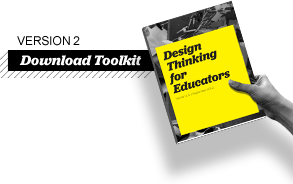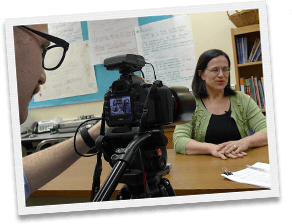Share A Story: Design Thinking for Educators


It is a mindset
Design Thinking is the confidence that everyone can be part of creating a more desirable future, and a process to take action when faced with a difficult challenge. That kind of optimism is well needed in education.
Classrooms and schools across the world are facing design challenges every single day, from teacher feedback systems to daily schedules. Wherever they fall on the spectrum of scale-the challenges educators are confronted with are real, complex, and varied. And as such, they require new perspectives, new tools, and new approaches. Design Thinking is one of them.
The design process is what puts
Design Thinking into action.
It's a structured approach to generating and developing ideas.
How do I
evolve it?
Educators across the nation have been using Design Thinking to solve challenges in their work. Projects range in scope and scale including design solutions- from curriculum, to space, to processes and to systems- addressing problems in the classroom and across entire districts.
How might my classroom be redesigned to better meet my students' needs?


Michael Schurr, a 2nd grade teacher in New York, realized that he never asked his students what would make them comfortable in the classroom. He decided to talk directly with his students to figure out the best design for their environment.
Based on his students' input, he was able to redesign his classroom to better address the needs and desires of his students. He lowered the bulletin boards so that his students could actually see the content he'd spent hours assembling, and created a more comfortable semi-private space for the students to study by rethinking the student cubby space. His students are more engaged, and move more fluidly in the classroom space. Now Michael consistently engages his students in helping him more effectively shape their learning experience.
Michael is using design to re-imagine his classroom through the lens of his students' needs.
How might we create a 21st century learning experience at our school?


The faculty at Ormondale Elementary School in California wondered if they were preparing their students well for the future. They decided it was time to corroboratively design an approach to teaching and learning that they felt was updated and relevant for the 21st century.
Collectively, they embarked on a design journey and came to an approach they call "Investigative Learning", which addresses students not as receivers of information, but as shapers of knowledge. The faculty continues to evolve and share this approach with new teachers through the creation of a Manual of Investigative Learning to keep track of their philosophy and methods. They have gained support from their school board, and have become recognized as a California Distinguished School.
The faculty at Ormondale Elementary School uses design to address the needs of their evolving student body.How might we redesign our approach to curriculum development and delivery to center around the needs and desires of our teachers and students?


With a movement toward student-centered and personalized instruction, the Howard County Public School System in Maryland is using Design Thinking to tackle next generation curriculum redesign incorporating 21st Century skills. Currently, there is a disconnect between the existing paper-based curriculum and the interactive digital resources that are now available anytime, anywhere for teachers and students.
Tapping into teacher, parent, and student behaviors in and outside of school, the design team collected inspiration around the ways that people engage with information and interact with curricular materials. Understanding the desires of teachers, students, parents, and administrators has helped the team rethink curriculum delivery as well as develop resources to replace, augment, and enhance current curriculum documents.
Howard County is using design to re-conceptualize curriculum creation and delivery to meet the needs of all learners.How might we redesign our high school to elevate student engagement and
academic outcomes?


Consistent low student achievement results at Castle High School in Hawaii demonstrated the need for a redesign and restructure of the school. Design Thinking Hawaii, a non-profit organization that engages volunteers to apply Design Thinking to big challenges, partnered with the Hawaii Department of Education to reimagine the Castle High experience.
Through a series of mini-charettes, Design Thinking Hawaii has collected the needs and interests of learners, teachers, and families and engaged the larger community to imagine new solutions that could help the school be more effective. The adopted plan captured the community's priorities in new content and structures, and Complex Area Superintendent Lea Albert is enabling the school and community to prototype and iterate core curriculum, character education, and support services. This is the first public-school model in Hawaii to co-design its offerings with community, targeting systemic educational problems.
Design Thinking Hawaii is using design to provide the state with input that will shape the redesign of Castle High and other schools in the community.
The Design Thinking Toolkit for Educators
This toolkit contains the process and methods of design along with the Designer's Workbook, adapted specifically for the context of K-12 education. It offers new ways to be intentional and collaborative when designing, and empowers educators to create impactful solutions.
At IDEO, we've been using similar processes, methods, and tools for years in tackling some dauntingly complex challenges. More often than not, we've experienced how Design Thinking helps to get to the next step. That's why we are excited to see how it can impact the world of education. Teachers at Riverdale Country School are starting to use design process to address challenges in their classrooms and schools, and together we've created this toolkit in order to share these processes more broadly.
This is an invitation to experiment with the design process. Let it inspire you to approach challenges differently, and experience how Design Thinking adds a new perspective to your work.

What value can design thinking offer to educators? What makes the design process relevant in an education context?
To find out, we spent time in classrooms, teacher's lounges, and hallways of private, public, and charter schools. We met teachers and administrators and spoke with professionals that work with educators. Our goal was to learn about the reality in which educators live, to inspire and inform the design of this toolkit.

Riverdale Country School is a Pre-K through Grade 12 independent school in New York City.
www.riverdale.eduIDEO (pronounced "eye-dee-oh") is an award-winning global design firm that takes a human-centered approach to helping organizations in the public and private sectors innovate and grow.
www.ideo.comWe want to hear from you! Please send us your comments, stories, movies, or photos of your experiences using this toolkit to create new design solutions for your schools.
[email protected]